Metrology and calibration of neutron measuring instruments
IRSN operates and is developing a large technical platform at the Cadarache center (Bouches du Rhône) for neutron metrology and calibration of neutron measuring instruments, particularly for radiation protection. Having been designated the national holder of neutron dosimetry reference standards by France’s national testing laboratory (LNE), IRSN must be able to produce perfectly controlled neutron fields and take measurements that are as accurate as possible. The platform enables it to test and carry out routine calibration of instruments, to calibrate them in realistic fields, i.e. similar to those encountered during actual use, and to determine how their response varies with neutron energy.
Background
People can be exposed to neutron radiation in the nuclear industry (power plants, fuel manufacture and reprocessing plants), in research laboratories, in the medical field or in the environment. Appropriate, correctly calibrated equipment is therefore necessary to monitor them.
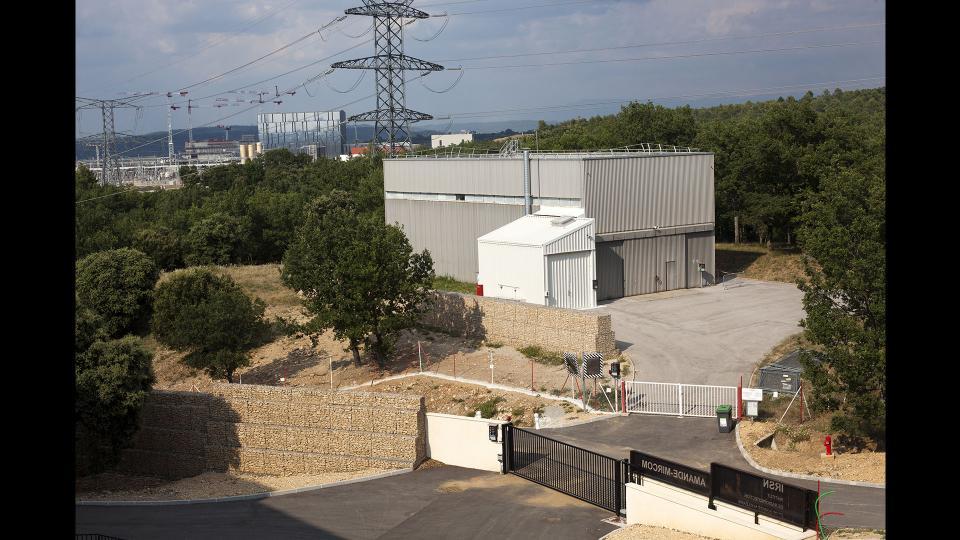
IRSN’s CEZANE and AMANDE facilities at Cadarache produce all the reference neutron field types recommended by international standards (ISO 8529 and ISO 12789) for calibrating neutron measuring instruments. It is the responsibility of the Microirradiation, Neutron Metrology and Dosimetry Laboratory (LMDN) to guarantee the production of national reference standards for fluence, i.e. the number of neutrons per unit area, and the derived dosimetric values.
These facilities are used to test and perform different types of calibration of neutron measuring equipment. Routine calibration is done at the CEZANE facility using the Van Gogh irradiator which has two sources: one made of americium-beryllium (241AmBe), and the other of californium (252Cf). In the CEZANE facility it is also possible to perform calibration in a realistic field, i.e. one with similar characteristics to the neutron fields encountered in the workplace. This is done using the T400 accelerator associated with the CANEL device, which can generate a fission neutron spectrum moderated using elements representative of the shielding used in the nuclear industry. Finally, the AMANDE facility can perform a third type of calibration, which consists of determining how instrument response varies as a function of neutron energy, by producing monoenergetic neutron beams with an energy of between 2 keV and 20 MeV.
Together these facilities form a technical platform with few equivalents worldwide. The addition of further moderator associated with the T400 accelerator is planned in the near future, to enable a thermal neutron field to be created (energy of less than 0.5 eV).
The AMANDE and CEZANE facilities are at the center of a 300-meter radius exclusion zone. This is unique worldwide for this type of facility and means that neutrons can be generated in structurally light experiment halls (with metallic walls) limiting the proportion of scattered neutrons at the calibration point.
Routine calibration: the VAN GOGH irradiator
The VAN GOGH irradiator consists of the two main radioactive sources recommended by the standard ISO 8529-1: 241AmBe and 252Cf.

When they are not in use, these sources are stored in a polyethylene container. Using compressed air in a guide tube, the sources are taken to their irradiation position 3.2 m above the ground, which limits the background noise due to neutrons scattered by the ground. A motorized calibration bench is used to position the instruments at the source or at any distance between 0 and 2 m; the conventional irradiation distance is 75 cm.
In addition to routine calibration activity, this irradiator is used to realign accredited laboratories with the national reference standards for neutron fluence and the derived dosimetric values (especially dose equivalents). Neutron flux values are determined directly from measurements of the neutron emission rate (number of neutrons emitted per second) of each source, performed in a manganese bath at the Laboratoire National Henri Becquerel (LNHB at CEA Saclay). The dosimetric values are derived from the fluence by applying the tabulated conversion coefficients given in the ISO 8529 standards [Ref.].
Calibration activities in this irradiator are accredited by the French accreditation committee (COFRAC), under the designation LA2.55 (scope available on www.cofrac.fr).
This irradiator also has a 137Cs gamma radiation source of 11 GBq, which can be used to test the photon sensitivity of the instruments requiring calibration.
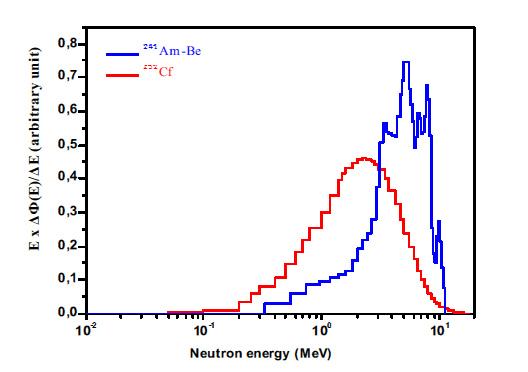
Characteristics of the ‘bare’ sources
The 241Am-Be source is covered with a 1 mm thick lead shield to limit the emission of photon radiation, whereas the 252Cf source is used without a shield.
The energy distribution of the neutron fluence associated with each of these sources is shown below.
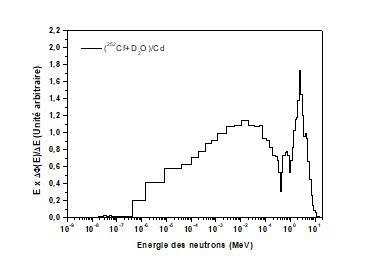
Moderated 252Cf source
To produce an energy distribution that is closer to those encountered in the workplace, the 252Cf source is placed in the center of a moderating heavy water sphere of radius 15 cm, with a 1.2 mm thick aluminum shell to which an 0.8 mm thick cadmium shell can be added; this configuration is the only one included in the ISO 8529-1 standard.
The two energy distributions of the fluence obtained with moderation are shown in the figure below [Ref].
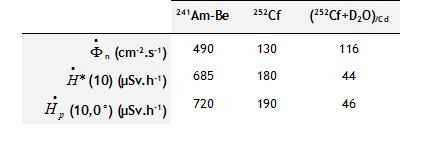
Fluxes and dose equivalent rates
The fluxes and dose equivalent rates (individual and ambient) at a distance of 75 cm from the source are presented in the table below.
Calibration in an intense field: the T400 accelerator
The T400 neutron generator is a 400 kV electrostatic accelerator bringing deuterons (deuterium nucleus) up to an energy of between 150 and 400 keV. These accelerated deuterons are sent to a deuterated titanium (TiD) target where their interactions with the deuterium atoms generate quasi-monoenergetic neutrons of around 3 MeV.
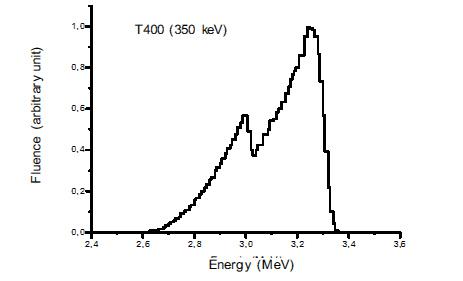
The main function of this generator is to supply high neutron fluxes of a few MeV. T400 nominally operates at an energy of 350 keV with a beam intensity of 2 mA. The target used is a thick target that completely stops the beam of charged particles. The deuteron beam is polluted by around 20% diatomic ions. This results in a neutron energy distribution consisting of two quasi-monoenergetic peaks with a full width at half maximum of several hundred keV, overlapping one another as shown in the figure on the right.
The neutron fluence is determined and monitored using the associated particle method: 3 silicon diodes are placed at the back of the target (175° angle) and detect the protons emitted simultaneously with the neutrons. The devices being tested can be placed at between 0 and 2 m from the target along the axis of the deuteron beam (0°).
The T400 accelerator is used for high flux irradiation with quasi-monoenergetic beams of 3 MeV. It therefore complements the possibilities offered by the AMANDE accelerator and the Van Gogh irradiator, which have lower flux and dose equivalent rates.
Calibration in a realistic field: the CANEL device
CANEL is used to create realistic neutron fields. These have two major advantages. The first is that they can be used to test instruments in an environment similar to real conditions (wide energy distribution, significant contamination with photons, variable neutron incidence angles, etc.), in full knowledge of the field’s characteristics. The second is that they can be used to calibrate radiation protection equipment in a neutron field that, at least in terms of energy distribution, is representative of the workplace where it will be used, as shown by the graph below, and they therefore enable a calibration coefficient to be defined that reflects the actual use of the instrument.
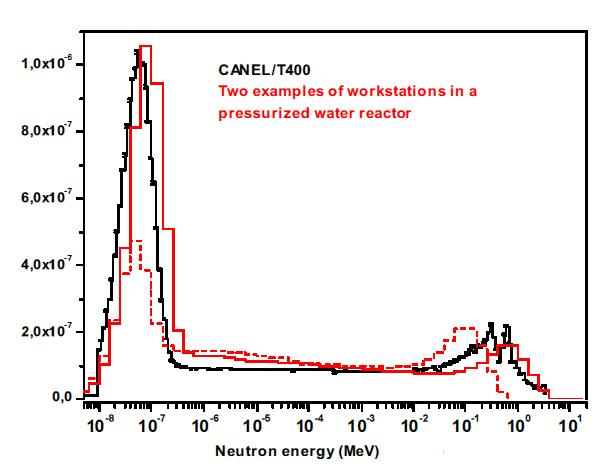
The realistic fields are used mainly for radiation protection. They were developed by IRSN in the 1990s. In the next few years IRSN will strengthen its position as world leader for this type of field by defining new configurations for CANEL to broaden its range of realistic fields with a maximum energy of 3 MeV.
CANEL, shown in the figure below, is a modular device that is placed around the target of the T400 neutron generator to produce these realistic neutron fields. Only two examples of the device, which is mentioned as an example in the ISO 12789 standard, exist worldwide.
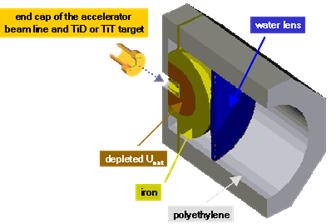
The principle of CANEL is that it generates a fission neutron spectrum within a depleted uranium shell. The fission neutrons are then moderated using elements representing shielding used in the nuclear industry: an iron shield with a polyethylene plate, all placed in a polyethylene duct 70 cm in diameter and 1 m in length. This polyethylene duct confines the scattered neutrons within the containment and directs the neutron field forwards. The equipment calibration point is along the axis of the deuteron beam, 50 cm from the output from CANEL.
Although only one configuration of CANEL is currently used, its modularity means that the thickness of the iron and polyethylene shields can be varied to generate realistic fields with different energy distributions.
Calibration in a monoenergetic field: the AMANDE facility
The AMANDE facility is designed to produce monoenergetic neutron fields. It consists of an accelerator of charged particles (protons and deuterons), which are accelerated then directed at a target consisting of a thin layer of scandium, lithium, tritium or deuterium deposited on a metallic surface. The interaction of the charged particles with the nuclei of these elements generates neutrons in the whole space. The corresponding nuclear reactions produce monoenergetic neutrons in a given direction for a given energy of the incident charged particle.
Monoenergetic neutron fields are used mainly to study instrument response as a function of energy.
See details of the AMANDE facility’s characteristics
Use in radiobiology
Since 2016, a second beam line has been installed at the accelerator output to produce a microbeam, MIRCOM, capable of depositing a predefined number of ions on living biological samples. The purpose of this is to study radiation-induced effects as part of radiobiology research programs. MIRCOM has been operational for radiobiology experiments since late 2018.
See details of the MIRCOM microbeam
Related research
In addition to its role of associate laboratory responsible for maintaining national reference standards and transferring them to secondary calibration laboratories, LMDN conducts neutron metrology research with two main aims:
- to develop new neutron fields for the calibration of neutron detection instruments and to improve knowledge of the existing fields;
- to develop reference instruments (standards) and measuring techniques to improve the measurement of neutron fluence and the derived dosimetric values.
To achieve the first aim, research projects aim to:
- measure more precisely the energy distribution of the CEZANE facility’s fields;
- define new configurations of CANEL to generate realistic fields with energy distributions representative of different workplaces encountered in the nuclear industry;
- create a thermal neutron field in which more than 99% of neutrons have an energy of less than 0.5eV, with a flux of several thousand neutrons per cm2 per second;
- participate, in collaboration with the German and British national metrology institutes, in the development of high energy quasi-monoenergetic neutron fields (between 25 MeV and 200 MeV) at the iThemba Labs facility in South Africa.
In terms of the second aim, the R&D projects concern:
- the development of standard recoil nuclei telescopes as part of a program contract with LNE, so that the neutron fluence and energy in AMANDE’s monoenergetic fields can be determined without prior calibration;
- the development of energy measurement in AMANDE’s monoenergetic fields using the time-of-flight technique;
- the use of new types of scintillators (e.g. stilbene, as part of a collaboration with the CEA) to determine the energy distributions of LMDN’s various facilities;
- the setting up of a gamma spectrometry system, traceable to the CEA’s LNHB reference standards, to determine the activation of gold foil, making it possible to work back to the reference fluence of the thermal field.
Finally, the reference neutron fields are also used to characterize the laboratory’s spectrometry systems (Bonner spheres systems, ROSPEC multidetector) used to determine the energy distributions of the neutrons encountered at workstations in the nuclear industry, in research laboratories, in the medical field and in the environment.
